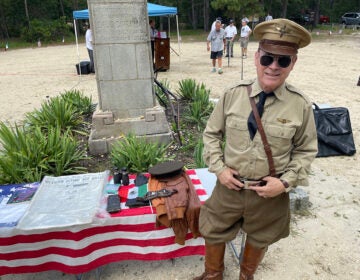Money as art on display at Princeton University
This is part of a series from Ilene Dube of The Artful Blogger.
How closely have you looked at your money lately? Artist Hanna von Goeler makes sure we see those dollar bills in a new way. Whose face is pictured? Is it the Mona Lisa? Bernie Madoff? Or what if Picasso’s nudes danced over the face of the greenback?
And what’s in the fine print? If Edvard Munch’s “The Scream” were howling on the dollar’s face, the writing might say, “Oh no! I missed the Edvard Munch show. Oh no oh no oh no!”
If it’s George Washington after all, perhaps he’s dyed his hair blond and had plastic surgery. “Want healthy look skin? 1-800 call Dr. Jonathan Zizmor.” Von Goeler experiments with George as African American.
In The Currency of an Altered State, on view at Princeton University’s Bernstein Gallery in the Woodrow Wilson School of Public and International Affairs through Dec. 6, Montclair-based von Goeler paints on bills to raise ethical, political and aesthetic questions. These gem-like miniature paintings evoke illuminated manuscripts.
“I started this series in part because I am terribly impractical when it comes to money matters and mining money for its visual, cultural, political, emotional and narrative content is the best way I have found to have a relationship with money,” the artist writes.
When you think about it, the dollar bill makes a wonderful surface on which to make art – it’s good archival quality paper that absorbs the paint, and it’s the perfect size for jotting down little epiphanies, such as “Recently at a dinner party the topic turned to the difference between little boys and little girls. One woman told that in her toddler’s play group there is a little boy who constantly chews his sandwich into the shape of a gun.” Or “As it turns out, money was not the obstacle after all.”
“I love the way worlds can intersect on this tiny piece of paper,” says the artist. “I’ve always been interested in the connections between ordinary life and the larger meta-narratives of history, power and culture. Painting on money also gives me some sense of power to determine — rather than be controlled by — money’s function within society.”
During her years as a struggling artist, von Goeler found her invented medium convenient – without a studio, she could work on the kitchen table or floor, and only needed a small amount of paint to fill her “canvas.” A dollar bill costs less than a sheet of watercolor paper, and you can paint a starry night sky around George’s curly tendrils. Von Goeler also uses pesos, Kwacha (Zambian currency) and Kyats (Myanmar).
But just what is the value of a dollar when you can turn it into a painting – say, painting everything white except George’s eyes, then painting tears falling from those eyes – and then sell it for much more? “I need income as much as anyone else,” responds von Geoler, “so I do sell the pieces and am happy when they find a good home. I have a multiple called ‘We.’ The price for that multiple is determined by a conversation between me and the buyer, because I wanted to make at least one piece accessible for just about anyone to buy at a price they deem fair.”
But isn’t this defacing government property? “As I see it, I am adding value or additional currency to the bills,” says von Goeler. “It is no longer the same object after I have added my currency. My interventions are like alchemy, creating an altered state. I believe that what I do falls under fair use.”
A closing reception will be held in the Bernstein Gallery on Thursday, December 6, 5 to 8 p.m., coinciding with ArtWalk, Princeton University Art Museum and the Arts Council of Princeton’s self-guided walking tour of art-loving venues in town. The gallery is located on the lower level of Robertson Hall in the Woodrow Wilson School. Hours: Mondaythrough Friday, 8:30 – 5:30 p.m., and by appointment on weekends.
The Artful Blogger is written by Ilene Dube and offers a look inside the art world of the greater Princeton area. Ilene Dube is an award-winning arts writer and editor, as well as an artist, curator and activist for the arts.
WHYY is your source for fact-based, in-depth journalism and information. As a nonprofit organization, we rely on financial support from readers like you. Please give today.




